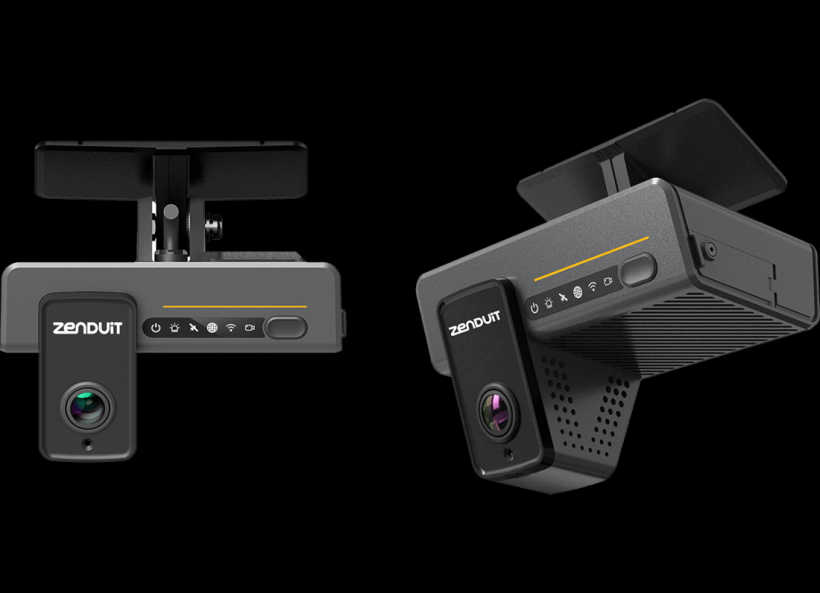Over the past decade, the fleet industry has seen significant advancements in technology. Automated tools have changed how fleets are monitored and managed; GPS tracking, in particular, has been a game-changer, providing real-time data on vehicle locations, routes, and driver behavior, and offering fleet managers a holistic overview of their fleet's operations.
As technology continues to evolve, so too have the solutions for fleet management. GPS tracking has paved the way for more sophisticated systems that integrate artificial intelligence (AI) and advanced driver-assistance systems (ADAS) to provide robust data sets for fleet managers and actionable, real-time feedback for drivers. These solutions not only enhance fleet safety, but also contribute significantly to cost savings, improved workflows and improved operational efficiency.
At the forefront of this technological evolution is the ZenduCAM ADAS dash camera. This cutting-edge device combines AI-powered dash cameras with ADAS for modern fleet management. This solution helps mitigate accidents, identify risky driving behavior, and provide drivers with immediate feedback and instruction.
Understanding GPS Tracking in Fleet Management
GPS tracking technology uses a combination of satellites and receivers to pinpoint the location of a vehicle, providing invaluable data on vehicle location, route history, and travel speeds. Over the years, GPS tracking has evolved from a simple location tool to a comprehensive fleet management solution that plays a crucial role in route optimization, fuel consumption monitoring, and overall operational efficiency.
One of the primary benefits of GPS tracking is the ability to monitor vehicle location in real-time. This has significantly improved route planning and optimization, ensuring that drivers take the most efficient routes possible and avoid unnecessary delays. The real-time data provided by GPS systems also improves driver accountability and performance, as fleet managers can easily identify and address any inefficiencies or deviations.
On the other hand, traditional GPS tracking systems often fall short when it comes to providing in-depth data analysis and reporting. While they can tell you where a vehicle is and where it has been, they may not provide detailed information on driver behavior, vehicle health, or other crucial data points that can further improve fleet operations. Additionally, many traditional GPS systems lack the ability to integrate seamlessly with other fleet management tools and systems, limiting their overall effectiveness.
By combining the benefits of traditional GPS tracking with sophisticated artificial intelligence and driver-assistance systems, these modern solutions offer a comprehensive approach to fleet management that addresses the limitations of traditional GPS tracking and takes fleet operations to the next level.
About Advanced Driver Assistance Systems
ADAS represents a significant evolution in vehicle technology. These systems enhance vehicle safety and assist drivers in navigating and managing the vehicle with ease. The primary components of ADAS include sensors, cameras, and artificial intelligence algorithms that work together to provide features such as lane departure warnings, adaptive cruise control, blind spot detection, and automated braking, among others.
The incorporation of ADAS in fleet management is relatively recent but has already proven to be a game-changer. These systems provide fleet operators with an additional layer of security by reducing the risk of accidents through proactive alerts and automated interventions. The emergence of ADAS in fleet management has marked a significant step towards fully autonomous vehicles and has paved the way for more innovative solutions that combine traditional GPS tracking with advanced safety features.
The ZenduCAM ADAS Dash Camera: A Closer Look

The ZenduCAM ADAS dash camera is an innovative fleet management solution that combines the benefits of traditional GPS tracking with cutting-edge artificial intelligence and advanced driver-assistance systems. It is a compact, AI-powered dash camera designed specifically for high-performance fleets.
Core features and functionalities of the ZenduCAM ADAS dash camera include real-time video and audio capture, in-cabin driver communication and coaching, custom multi-channel connectivity with easy installation, and enhanced driver safety through DSC and facial AI capabilities. These features work together to provide a comprehensive solution for fleet managers to monitor driver behavior, enhance vehicle safety, and ensure compliance with transportation regulations.
What sets the ZenduCAM ADAS dash camera apart from traditional GPS tracking solutions and other ADAS products is its holistic approach to fleet management. The integration of AI and ADAS technology provides a more accurate and detailed analysis of driver behavior, which in turn enables fleet managers to make data-driven decisions that improve overall fleet performance. Moreover, its plug-and-play installation, combined with a rugged and compact exterior shell, makes it an ideal solution for fleets of all sizes and types.
Benefits of Integrating Advanced ADAS with Fleet Management
Enhanced driver safety and performance monitoring
ADAS provides fleet managers with the ability to monitor driver behavior in real-time, ensuring their safety and compliance with road regulations. Features such as DSC and Facial AI capabilities can record and assess risky driving behaviors like tired or distracted driving, speeding, and the absence of a seatbelt, allowing fleet managers to provide immediate feedback and instruction to drivers.
Improved fleet efficiency and cost-effectiveness
AI-powered features and advanced algorithms enable efficient route optimization and workload distribution among drivers, reducing drive times and boosting productivity. This, in turn, contributes to increased revenue for fleet operators.
Streamlined compliance and reporting
Built-in GPS and advanced ADAS technology can automate logs and reports, ensuring adherence to transportation regulations and minimizing manual record-keeping errors and administrative time.
Better data analysis for informed decision-making
ADAS technology leverages data sets to provide fleet managers with comprehensive data analytics, enabling them to make informed decisions regarding route optimization, carrier selection, and pricing strategies.
The Future of Fleet Management: Beyond ADAS
Let's take a glimpse into the future of fleet management, with the likelihood of even more sophisticated systems on the horizon.
Predicted advancements in ADAS technology
The continuous evolution of ADAS technology will likely lead to the development of more sophisticated systems that offer even greater levels of support and autonomy for drivers. This may include enhanced object and hazard detection, real-time decision-making assistance, and advanced navigation capabilities.
The role of AI and machine learning in fleet management
AI and machine learning are expected to play a crucial role in the future of fleet management. These technologies will enable more accurate data analysis, predictive maintenance, and automated decision-making. As a result, fleet managers will be better equipped to optimize operations, reduce costs, and enhance overall fleet performance.
Integration with other emerging technologies
The integration of ADAS with other emerging technologies, such as the Internet of Things (IoT), augmented reality (AR), and virtual reality (VR), will likely lead to the development of more comprehensive fleet management solutions. These solutions will provide a holistic view of fleet operations and facilitate more informed and efficient decision-making.
Final Thoughts
The shift from basic GPS tracking to advanced ADAS solutions marks a significant milestone in the evolution of fleet management. These innovations are pivotal in enhancing driver safety, improving fleet efficiency, and ensuring compliance with regulations. AI-powered features and advanced algorithms have revolutionized the way fleet managers monitor driver performance, ensure compliance, and make informed decisions.
As the logistics and transportation industry continues to evolve, it is crucial for fleet managers to stay ahead of the curve by adopting advanced technologies, which not only provide immediate benefits but also lay the foundation for a more robust, efficient, and future-ready fleet management strategy.















